Quantitative Raman Analysis of Carotenoid Protein Complexes in Aqueous Solution
Abstract
:1. Introduction
2. Results
2.1. UV/Vis Spectroscopy of Carotenoid: BSA Complexes
2.2. Raman Spectroscopic Analysis of Beta Carotene/BSA Complexes
2.3. Raman Spectroscopic Analysis of Carotenoid/BSA Complexes: Multivariate Regression Analysis
2.4. Quantitative Analysis of Beta Carotene, Lutein and Zeaxanthin
2.5. Differential Analysis of Beta Carotene, Lutein and Zeaxanthin
2.6. Quantitative Analysis of Beta Carotene, Lutein and Zeaxanthin
3. Discussion
4. Materials and Methods
4.1. Sample Preparation
4.2. Absorbance Measurement
4.3. Raman Analysis
4.4. Raman Spectral Pre-Processing
4.5. Self Absorption Correction
4.6. Partial Least-Squares Regression Analysis and Cross Validation
4.7. Principal Components Analysis
4.8. Nonlinear Least-Squares Curve Fitting
Supplementary Materials
Author Contributions
Funding
Institutional Review Board Statement
Informed Consent Statement
Data Availability Statement
Conflicts of Interest
References
- Bhatt, T.; Patel, K. Carotenoids: Potent to Prevent Diseases Review. Nat. Prod. Bioprospect. 2020, 10, 109. [Google Scholar] [CrossRef] [PubMed]
- Mezzomo, N.; Ferreira, S.R.S. Carotenoids Functionality, Sources, and Processing by Supercritical Technology: A Review. J. Chem. 2016, 2016, 3164312. [Google Scholar] [CrossRef] [Green Version]
- Kiokias, S.; Proestos, C.; Varzakas, T. A Review of the Structure, Biosynthesis, Absorption of Carotenoids-Analysis and Properties of Their Common Natural Extracts. Curr. Res. Nutr. Food Sci. J. 2016, 4, 25–37. [Google Scholar] [CrossRef]
- Amengual, J. Bioactive Properties of Carotenoids in Human Health. Nutrients 2019, 11, 2388. [Google Scholar] [CrossRef] [PubMed] [Green Version]
- Bhosale, P.; Ermakov, I.V.; Ermakova, M.R.; Gellermann, W.; Bernstein, P.S. Resonance Raman Quantification of Nutritionally Important Carotenoids in Fruits, Vegetables, and Their Juices in Comparison to High-Pressure Liquid Chromatography Analysis. J. Agric. Food Chem. 2004, 52, 3281–3285. [Google Scholar] [CrossRef]
- Talwar, D.; Ha, T.K.; Cooney, J.; Brownlee, C.; St JO’Reilly, D. A Routine Method for the Simultaneous Measurement of Retinol, α-Tocopherol and Five Carotenoids in Human Plasma by Reverse Phase HPLC. Clin. Chim. Acta 1998, 270, 85–100. [Google Scholar] [CrossRef]
- Ermakov, I.V.; Sharifzadeh, M.; Ermakova, M.; Gellermann, W. Resonance Raman Detection of Carotenoid Antioxidants in Living Human Tissue. J. Biomed. Opt. 2005, 10, 064028. [Google Scholar] [CrossRef]
- De Oliveira, V.E.; Castro, H.V.; Edwards, H.G.M.; de Oliveira, L.F.C. Carotenes and Carotenoids in Natural Biological Samples: A Raman Spectroscopic Analysis. J. Raman Spectrosc. 2009, 41, 642–650. [Google Scholar] [CrossRef]
- Brown, L.; Rimm, E.B.; Seddon, J.M.; Giovannucci, E.L.; Chasan-Taber, L.; Spiegelman, D.; Willett, W.C.; Hankinson, S.E. A Prospective Study of Carotenoid Intake and Risk of Cataract Extraction in US Men. Am. J. Clin. Nutr. 1999, 70, 517–524. [Google Scholar] [CrossRef] [Green Version]
- Christen, W.G.; Liu, S.; Glynn, R.J.; Gaziano, J.M.; Buring, J.E. A Prospective Study of Dietary Carotenoids, Vitamins C and E, and Risk of Cataract in Women. Arch. Ophthalmol. 2008, 126, 102. [Google Scholar] [CrossRef] [Green Version]
- Delcourt, C.; Carrière, I.; Delage, M.; Barberger-Gateau, P.; Schalch, W.; Lacroux, A.; Fourrey, S.; Covacho, M.J.; Canet, C.; Paillard, P.; et al. Plasma Lutein and Zeaxanthin and Other Carotenoids as Modifiable Risk Factors for Age-Related Maculopathy and Cataract: The POLA Study. Investig. Ophthalmol. Vis. Sci. 2006, 47, 2329–2335. [Google Scholar] [CrossRef] [PubMed]
- Sabour-Pickett, S.; Nolan, J.M.; Loughman, J.; Beatty, S. A Review of the Evidence Germane to the Putative Protective Role of the Macular Carotenoids for Age-Related Macular Degeneration. Mol. Nutr. Food Res. 2012, 56, 270–286. [Google Scholar] [CrossRef] [PubMed] [Green Version]
- Li, B.; George, E.W.; Rognon, G.T.; Gorusupudi, A.; Ranganathan, A.; Chang, F.-Y.; Shi, L.; Frederick, J.M.; Bernstein, P.S. Imaging Lutein and Zeaxanthin in the Human Retina with Confocal Resonance Raman Microscopy. Proc. Natl. Acad. Sci. USA 2020, 117, 12352–12358. [Google Scholar] [CrossRef] [PubMed]
- Ahmed, S.S.; Lott, M.N.; Marcus, D.M. The Macular Xanthophylls. Surv. Ophthalmol. 2005, 50, 183–193. [Google Scholar] [CrossRef]
- Adar, F. Carotenoids—Their Resonance Raman Spectra and How They Can Be Helpful in Characterizing a Number of Biological Systems. Available online: https://www.spectroscopyonline.com/view/carotenoids-their-resonance-raman-spectra-and-how-they-can-be-helpful-characterizing-number-biologic (accessed on 19 April 2022).
- Britton, G. Carotenoids. In Natural Food Colorants; Springer: Boston, MA, USA, 1996; pp. 197–243. [Google Scholar]
- John, N.; George, S. Raman Spectroscopy. In Spectroscopic Methods for Nanomaterials Characterization; Elsevier: Amsterdam, The Netherlands, 2017; pp. 95–127. [Google Scholar] [CrossRef]
- Martus, P.; Stroux, A.; Budde, W.M.; Mardin, C.Y.; Korth, M.; Jonas, J.B. Predictive Factors for Progressive Optic Nerve Damage in Various Types of Chronic Open-Angle Glaucoma. Am. J. Ophthalmol. 2005, 139, 999–1009. [Google Scholar] [CrossRef]
- Nielsen, F.; Mikkelsen, B.B.; Nielsen, J.B.; Andersen, H.R.; Grandjean, P. Plasma Malondialdehyde as Biomarker for Oxidative Stress: Reference Interval and Effects of Life-Style Factors. Clin. Chem. 1997, 43, 1209–1214. [Google Scholar] [CrossRef] [Green Version]
- Fork, D.C.; Amesz, J. Light-induced shifts in the absorption spectrum of carotenoids in red and brown Algae. Photochem. Photobiol. 2008, 6, 913–918. [Google Scholar] [CrossRef]
- Liu, C.-H.; Zhou, Y.; Sun, Y.; Li, J.Y.; Zhou, L.X.; Boydston-White, S.; Masilamani, V.; Zhu, K.; Pu, Y.; Alfano, R.R. Resonance Raman and Raman Spectroscopy for Breast Cancer Detection. Technol. Cancer Res. Treat. 2013, 12, 371–382. [Google Scholar] [CrossRef]
- Lu, L.; Shi, L.; Secor, J.; Alfano, R. Resonance Raman Scattering of β-Carotene Solution Excited by Visible Laser Beams into Second Singlet State. J. Photochem. Photobiol. B Biol. 2018, 179, 18–22. [Google Scholar] [CrossRef]
- Parker, R.S. Carotenoids in Human Blood and Tissues. J. Nutr. 1989, 119, 101–104. [Google Scholar] [CrossRef] [Green Version]
- Vershinin, A. Biological Functions of Carotenoids-Diversity and Evolution. BioFactors 1999, 10, 99–104. [Google Scholar] [CrossRef] [PubMed]
- Arteni, A.-A.; Fradot, M.; Galzerano, D.; Mendes-Pinto, M.M.; Sahel, J.-A.; Picaud, S.; Robert, B.; Pascal, A.A. Structure and Conformation of the Carotenoids in Human Retinal Macular Pigment. PLoS ONE 2015, 10, e0135779. [Google Scholar] [CrossRef] [PubMed]
- Vetter, W.; Englert, G.; Rigassi, N.; Schwieter, U. Spectroscopic Methods. In Carotenoids; Osler, O., Ed.; Birkhäuser Verlag: Boston, MA, USA, 1971. [Google Scholar]
- Li, X.; Wang, G.; Chen, D.; Lu, Y. β-Carotene and Astaxanthin with Human and Bovine Serum Albumins. Food Chem. 2015, 179, 213–221. [Google Scholar] [CrossRef] [PubMed]
- Omidvar, Z.; Asoodeh, A.; Chamani, J. Studies on the Antagonistic Behavior Between Cyclophosphamide Hydrochloride and Aspirin with Human Serum Albumin: Time-Resolved Fluorescence Spectroscopy and Isothermal Titration Calorimetry. J. Solut. Chem. 2013, 42, 1005–1017. [Google Scholar] [CrossRef]
- Chang, H.T.; Cheng, H.; Han, R.M.; Zhang, J.P.; Skibsted, L.H. Binding to Bovine Serum Albumin Protects β-Carotene against Oxidative Degradation. J. Agric. Food Chem. 2016, 64, 5951–5957. [Google Scholar] [CrossRef] [PubMed]
- Reszczynska, E.; Welc, R.; Grudzinski, W.; Trebacz, K.; Gruszecki, W.I. Carotenoid Binding to Proteins: Modeling Pigment Transport to Lipid Membranes. Arch. Biochem. Biophys. 2015, 584, 125–133. [Google Scholar] [CrossRef] [PubMed]
- Brady, W.E.; Mares-Perlman, J.A.; Bowen, P.; Stacewicz-Sapuntzakis, M. Human Serum Carotenoid Concentrations Are Related to Physiologic and Lifestyle Factors. J. Nutr. 1996, 126, 129–137. [Google Scholar] [CrossRef] [Green Version]
- Burrows, T.L.; Williams, R.; Rollo, M.; Wood, L.; Garg, M.L.; Jensen, M.; Collins, C.E. Plasma Carotenoid Levels as Biomarkers of Dietary Carotenoid Consumption: A Systematic Review of the Validation Studies. J. Nutr. Intermed. Metab. 2015, 2, 15–64. [Google Scholar] [CrossRef] [Green Version]
- Bonnier, F.; Baker, M.J.; Byrne, H.J. Vibrational Spectroscopic Analysis of Body Fluids: Avoiding Molecular Contamination Using Centrifugal Filtration. Anal. Methods 2014, 6, 5155–5160. [Google Scholar] [CrossRef] [Green Version]
- Sujak, A.; Okulski, W.; Gruszecki, W.I. Organisation of Xanthophyll Pigments Lutein and Zeaxanthin in Lipid Membranes Formed with Dipalmitoylphosphatidylcholine. Biochim. Biophys. Acta-Biomembr. 2000, 1509, 255–263. [Google Scholar] [CrossRef] [Green Version]
- Qu, F.; Fu, H.; Li, Y.; Sun, C.; Li, Z.; Gong, N.; Men, Z. Temperature Effect on Electronic and Vibrational Properties of β-Carotene Aggregates in Aqueous Ethanol Solution. Dye. Pigment. 2019, 166, 323–329. [Google Scholar] [CrossRef]
- Andersson, P.O.; Gillbro, T.; Ferguson, L.; Cogdell, R.J. Absorption spectral shifts of carotenoids related to medium polarizability. Photochem. Photobiol. 1991, 54, 353–360. [Google Scholar] [CrossRef]
- Ouyang, S.; Sun, C.; Zhou, M.; Li, D.; Wang, W.; Qu, G.; Li, Z.; Gao, S.; Yang, J.; Ouyang, S.; et al. Effect of Solution Concentration on the Structured Order and Optical Properties of Short-Chain Polyene Biomolecules. Sci. China Phys. Mech. Astron. 2010, 53, 1646–1650. [Google Scholar] [CrossRef]
- Meinhardt-Wollweber, M.; Suhr, C.; Kniggendorf, A.K.; Roth, B. Absorption and Resonance Raman Characteristics of β-Carotene in Water-Ethanol Mixtures, Emulsion and Hydrogel. AIP Adv. 2018, 8, 055320. [Google Scholar] [CrossRef] [Green Version]
- Lu, L.; Liu, G.; Ni, X.; Luo, X.; Lu, L.; Liu, G.; Ni, X.; Luo, X. Spectral Analysis of Interaction between Carotenoid and Tyrosine in Ethanol-Water Solution. Russ. J. Phys. Chem. 2015, 89, 417–422. [Google Scholar] [CrossRef]
- Lu, L.; Ni, X.; Luo, X. Influence of Phenylalanine on Carotenoid Aggregation. J. Appl. Spectrosc. 2015, 81, 1068–1072. [Google Scholar] [CrossRef]
- Marini, A.; Muñoz-Losa, A.; Biancardi, A.; Mennucci, B. What Is Solvatochromism? J. Phys. Chem. B 2010, 114, 17128–17135. [Google Scholar] [CrossRef]
- Olson, J.A. Serum Levels of Vitamin A and Carotenoids as Reflectors of Nutritional Status. J. Natl. Cancer Inst. 1984, 73, 1439–1444. [Google Scholar] [CrossRef]
- Dahm, D.J. Explaining Some Light Scattering Properties of Milk Using Representative Layer Theory. J. Near Infrared Spectrosc. 2013, 21, 323–339. [Google Scholar] [CrossRef]
- Minton, A.P.; Edelhoch, H. Light Scattering of Bovine Serum Albumin Solutions: Extension of the Hard Particle Model to Allow for Electrostatic Repulsion. Biopolymers 1982, 21, 451–458. [Google Scholar] [CrossRef]
- Kerr, L.T.; Hennelly, B.M. A Multivariate Statistical Investigation of Background Subtraction Algorithms for Raman Spectra of Cytology Samples Recorded on Glass Slides. Chemom. Intell. Lab. Syst. 2016, 158, 61–68. [Google Scholar] [CrossRef]
- Relative Intensity Correction Standards for Fluorescence and Raman Spectroscopy|NIST. Available online: https://www.nist.gov/programs-projects/relative-intensity-correction-standards-fluorescence-and-raman-spectroscopy (accessed on 11 July 2022).
- Parachalil, D.R.; Bruno, C.; Bonnier, F.; Blasco, H.; Chourpa, I.; McIntyre, J.; Byrne, H.J. Raman Spectroscopic Screening of High and Low Molecular Weight Fractions of Human Serum. Analyst 2019, 144, 4295–4311. [Google Scholar] [CrossRef] [PubMed]
- Kinalwa, M.N.; Blanch, E.W.; Doig, A.J. Accurate Determination of Protein Secondary Structure Content from Raman and Raman Optical Activity Spectra. Anal. Chem. 2010, 82, 6347–6349. [Google Scholar] [CrossRef] [PubMed]
- Tschirner, N.; Schenderlein, M.; Brose, K.; Schlodder, E.; Mroginski, M.A.; Hildebrandt, P.; Thomsen, C. Raman Excitation Profiles of β-Carotene-Novel Insights into the Nature of the N1-Band. Phys. Status Solidi 2008, 245, 2225–2228. [Google Scholar] [CrossRef]
- Robert, B. The Electronic Structure, Stereochemistry and Resonance Raman Spectroscopy of Carotenoids. In The Photochemistry of Carotenoids; Kluwer Academic Publishers: Dordrecht, The Netherlands, 1999; Volume 8, pp. 189–201. [Google Scholar]
- Okamoto, H.; Sekimoto, Y.; Tasumi, M.; Okamoto, H.; Sekimoto, Y.; Tasumi, M. Assignment and Anharmonicity Analysis of Overtone and Combination Bands Observed in the Resonance Raman Spectra of Carotenoids. Spectrochim. Acta Part A Mol. Spectrosc. 1994, 50, 1467–1473. [Google Scholar] [CrossRef]
- Horiue, H.; Sasaki, M.; Yoshikawa, Y.; Toyofuku, M.; Shigeto, S. Raman Spectroscopic Signatures of Carotenoids and Polyenes Enable Label-Free Visualization of Microbial Distributions within Pink Biofilms. Sci. Rep. 2020, 10, 7704. [Google Scholar] [CrossRef] [PubMed]
- Merlin, J.C. Resonance Raman Spectroscopy of Carotenoids and Carotenoid-Containing Systems. Pure Appl. Chem. 1985, 57, 785–792. [Google Scholar] [CrossRef]
- Kichou, H.; Munnier, E.; Dancik, Y.; Kemel, K.; Byrne, H.J.; Tfayli, A.; Bertrand, D.; Soucé, M.; Chourpa, I.; Bonnier, F. Estimating the Analytical Performance of Raman Spectroscopy for Quantification of Active Ingredients in Human Stratum Corneum. Molecules 2022, 27, 2843. [Google Scholar] [CrossRef]
- Parachalil, D.R.; Mcintyre, J.; Byrne, H.J.; Parachalil, R.; Byrne, J.; Rajan Parachalil, D. Potential of Raman Spectroscopy for the Analysis of Plasma/Serum in the Liquid State: Recent Advances. Anal. Bioanal. Chem. 2020, 412, 1993–2007. [Google Scholar] [CrossRef] [Green Version]
- Bendich, A.; Olson, J.A. Biological Actions of Carotenoids. FASEB J. 1989, 3, 1927–1932. [Google Scholar] [CrossRef]
- Bendich, A. Biological Functions of Dietary Carotenoids. Ann. N. Y. Acad. Sci. 1993, 691, 61–67. [Google Scholar] [CrossRef] [PubMed]
- Hoskins, L.C. Resonance Raman Spectroscopy of β-Carotene and Lycopene: A Physical Chemistry Experiment. J. Chem. Educ. 1984, 61, 460–462. [Google Scholar] [CrossRef]
- Høstmark, A.T.; Tomten, S.E.; Berg, J.E. Serum Albumin and Blood Pressure: A Population-Based, Cross-Sectional Study. J. Hypertens. 2005, 23, 725–730. [Google Scholar] [CrossRef]
- Herrmann, F.R.; Safran, C.; Levkoff, S.E.; Minaker, K.L. Serum Albumin Level on Admission as a Predictor of Death, Length of Stay, and Readmission. Arch. Intern. Med. 1992, 152, 125–130. [Google Scholar] [CrossRef] [PubMed]
- Mendes-Pinto, M.M.; LaFountain, A.M.; Stoddard, M.C.; Prum, R.O.; Frank, H.A.; Robert, B. Variation in Carotenoid-Protein Interaction in Bird Feathers Produces Novel Plumage Coloration. J. R. Soc. Interface 2012, 9, 3338–3350. [Google Scholar] [CrossRef] [Green Version]
- Gong, N.; Fu, H.; Wang, S.; Cao, X.; Li, Z.; Sun, C.; Men, Z. All-Trans-β-Carotene Absorption Shift and Electron-Phonon Coupling Modulated by Solvent Polarizability. J. Mol. Liq. 2018, 251, 417–422. [Google Scholar] [CrossRef]
- Liu, W.L.; Zheng, Z.R.; Zhu, R.B.; Liu, Z.G.; Xu, D.P.; Yu, H.M.; Wu, W.Z.; Li, A.H.; Yang, Y.Q.; Su, W.H. Effect of Pressure and Solvent on Raman Spectra of All-Trans-Beta-Carotene. J. Phys. Chem. A 2007, 111, 10044–10049. [Google Scholar] [CrossRef] [PubMed]
- Dudek, M.; Zajac, G.; Kaczor, A.; Baranska, M. Resonance Raman Optical Activity of Zeaxanthin Aggregates. J. Raman Spectrosc. 2017, 48, 673–679. [Google Scholar] [CrossRef]
- Wang, C.; Berg, C.J.; Hsu, C.C.; Merrill, B.A.; Tauber, M.J. Characterization of Carotenoid Aggregates by Steady-State Optical Spectroscopy. J. Phys. Chem. B 2012, 116, 10617–10630. [Google Scholar] [CrossRef]
- Zajac, G.; Lasota, J.; Dudek, M.; Kaczor, A.; Baranska, M. Pre-Resonance Enhancement of Exceptional Intensity in Aggregation-Induced Raman Optical Activity (AIROA) Spectra of Lutein Derivatives. Spectrochim. Acta Part A Mol. Biomol. Spectrosc. 2017, 173, 356–360. [Google Scholar] [CrossRef]
- Shreve, A.P.; Trautman, J.K.; Owens, T.G.; Albrecht, A.C. Determination of the S2 Lifetime of β-Carotene. Chem. Phys. Lett. 1991, 178, 89–96. [Google Scholar] [CrossRef]
- Bonnier, F.; Mehmood, A.; Knief, P.; Meade, A.D.; Hornebeck, W.; Lambkin, H.; Flynn, K.; McDonagh, V.; Healy, C.; Lee, T.C.; et al. In Vitro Analysis of Immersed Human Tissues by Raman Microspectroscopy. J. Raman Spectrosc. 2011, 42, 888–896. [Google Scholar] [CrossRef] [Green Version]
- Hendrickson, S.J.; Willett, W.C.; Rosner, B.A.; Eliassen, A.H. Food Predictors of Plasma Carotenoids. Nutrients 2013, 5, 4051–4066. [Google Scholar] [CrossRef] [PubMed]
- Newby, P.K.; Hu, F.B.; Rimm, E.B.; Smith-Warner, S.A.; Feskanich, D.; Sampson, L.; Willett, W.C. Reproducibility and Validity of the Diet Quality Index Revised as Assessed by Use of a Food-Frequency Questionnaire. Am. J. Clin. Nutr. 2003, 78, 941–949. [Google Scholar] [CrossRef] [PubMed] [Green Version]
- Shai, I.; Rosner, B.A.; Shahar, D.R.; Vardi, H.; Azrad, A.B.; Kanfi, A.; Schwarzfuchs, D.; Fraser, D. Dietary Evaluation and Attenuation of Relative Risk: Multiple Comparisons between Blood and Urinary Biomarkers, Food Frequency, and 24-Hour Recall Questionnaires: The DEARR Study. J. Nutr. 2005, 135, 573–579. [Google Scholar] [CrossRef] [Green Version]
- Heinrich, U.; Gärtner, C.; Wiebusch, M.; Eichler, O.; Sies, H.; Tronnier, H.; Stahl, W. Supplementation with β-Carotene or a Similar Amount of Mixed Carotenoids Protects Humans from UV-Induced Erythema. J. Nutr. 2003, 133, 98–101. [Google Scholar] [CrossRef]
- Thomson, C.A.; Stendell-Hollis, N.R.; Rock, C.L.; Cussler, E.C.; Flatt, S.W.; Pierce, J.P. Plasma and Dietary Carotenoids Are Associated with Reduced Oxidative Stress in Women Previously Treated for Breast Cancer. Cancer Epidemiol. Biomarkers. Prev. 2007, 16, 2008–2023. [Google Scholar] [CrossRef] [Green Version]
- Bone, R.A.; Landrum, J.T.; Guerra, L.H.; Ruiz, C.A. Biochemical and Molecular Actions of Nutrients Lutein and Zeaxanthin Dietary Supplements Raise Macular Pigment Density and Serum Concentrations of These Carotenoids in Humans. J. Nutr. 2003, 133, 992–998. [Google Scholar] [CrossRef]
- Parachalil, D.R.; Brankin, B.B.; Mcintyre, J. Raman Spectroscopic Analysis of High Molecular Weight Proteins in Solution-Considerations for Sample Analysis and Data Pre-Processing. Analyst 2018, 143, 5987–5998. [Google Scholar] [CrossRef] [Green Version]
- Savitzky, A.; Golay, M.J.E. Smoothing and Differentiation of Data by Simplified Least Squares Procedures. Anal. Chem. 1964, 36, 1627–1639. [Google Scholar] [CrossRef]
- Uriarte, L.M.; Bonales, L.J.; Dubessy, J.; Lobato, A.; Baonza, V.G.; Cáceres, M. The Self-Absorption Phenomenon in Quantitative Raman Spectroscopy and How to Correct Its Effects. Microchem. J. 2018, 139, 134–138. [Google Scholar] [CrossRef]
- Muehlethaler, C.; Lombardi, J.R.; Leona, M. Sample Self-Absorption in Surface-Enhanced Raman Spectroscopy (SERS): Influence of the Resonance, Dilution and Depth of the Measurements. J. Raman Spectrosc. 2017, 48, 647–652. [Google Scholar] [CrossRef]
- Swinehart, D.F. The Beer-Lambert Law. J. Chem. Educ. 1962, 39, 333. [Google Scholar] [CrossRef]
- Mayerhöfer, T.G.; Pipa, A.V.; Popp, J. Beer’s Law-Why Integrated Absorbance Depends Linearly on Concentration. ChemPhysChem 2019, 20, 2748–2753. [Google Scholar] [CrossRef]
- Wold, S.; Martens, H.; Wold, H. The Multivariate Calibration Problem in Chemistry Solved by the PLS Method. In Matrix Pencils; Springer: Berlin/Heidelberg, Germany, 1983; pp. 286–293. [Google Scholar]
- Liland, K.H.; Stefansson, P.; Indahl, U.G. Much Faster Cross-validation in PLSR-modelling by Avoiding Redundant Calculations. J. Chemom. 2020, 34, e3201. [Google Scholar] [CrossRef]
- Bonnier, F.; Byrne, H.J. Understanding the Molecular Information Contained in Principal Component Analysis of Vibrational Spectra of Biological Systems. Analyst 2012, 137, 322–332. [Google Scholar] [CrossRef] [PubMed] [Green Version]
- Korenius, T.; Laurikkala, J.; Juhola, M. On Principal Component Analysis, Cosine and Euclidean Measures in Information Retrieval. Inf. Sci. 2007, 177, 4893–4905. [Google Scholar] [CrossRef]
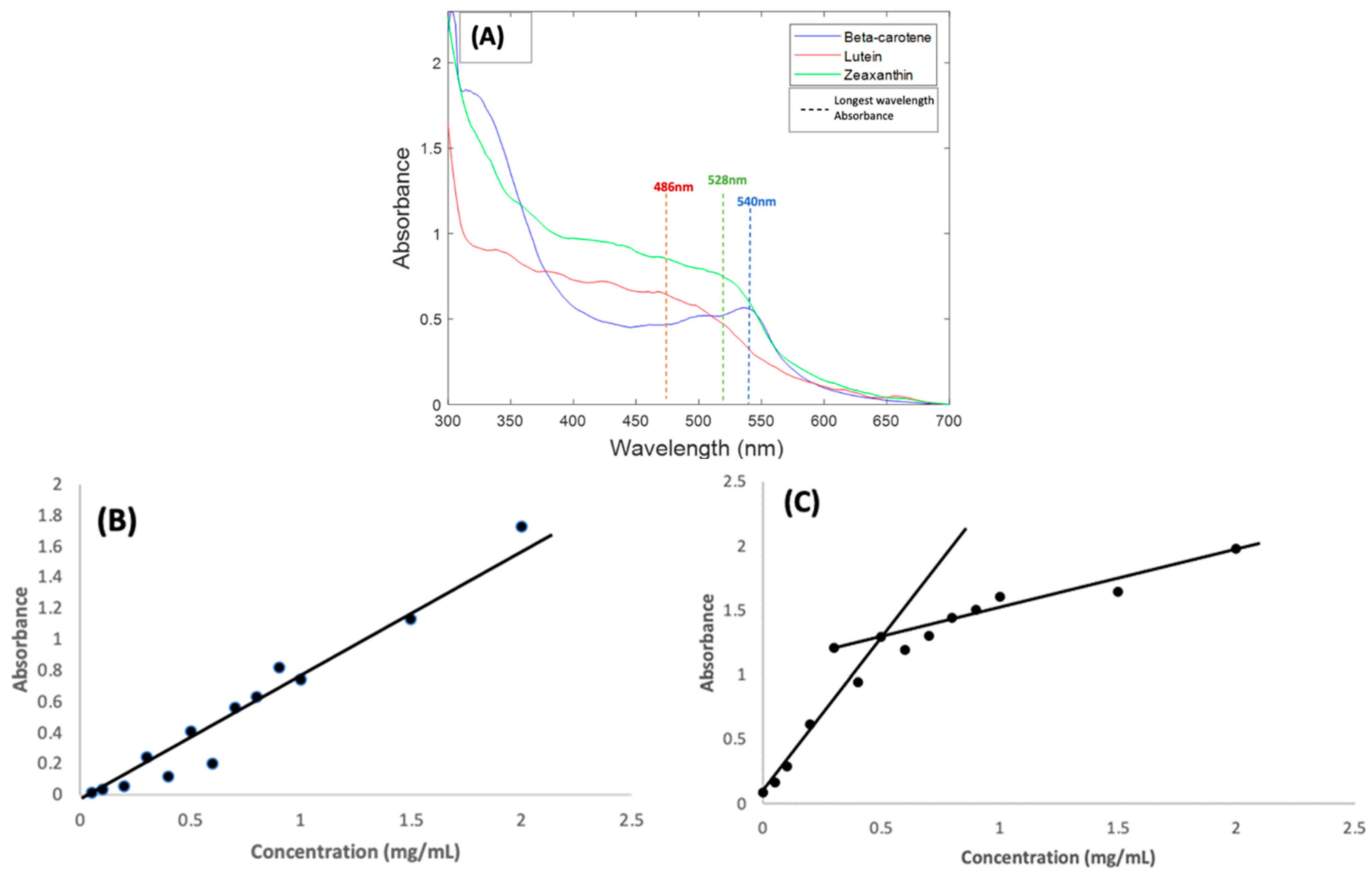


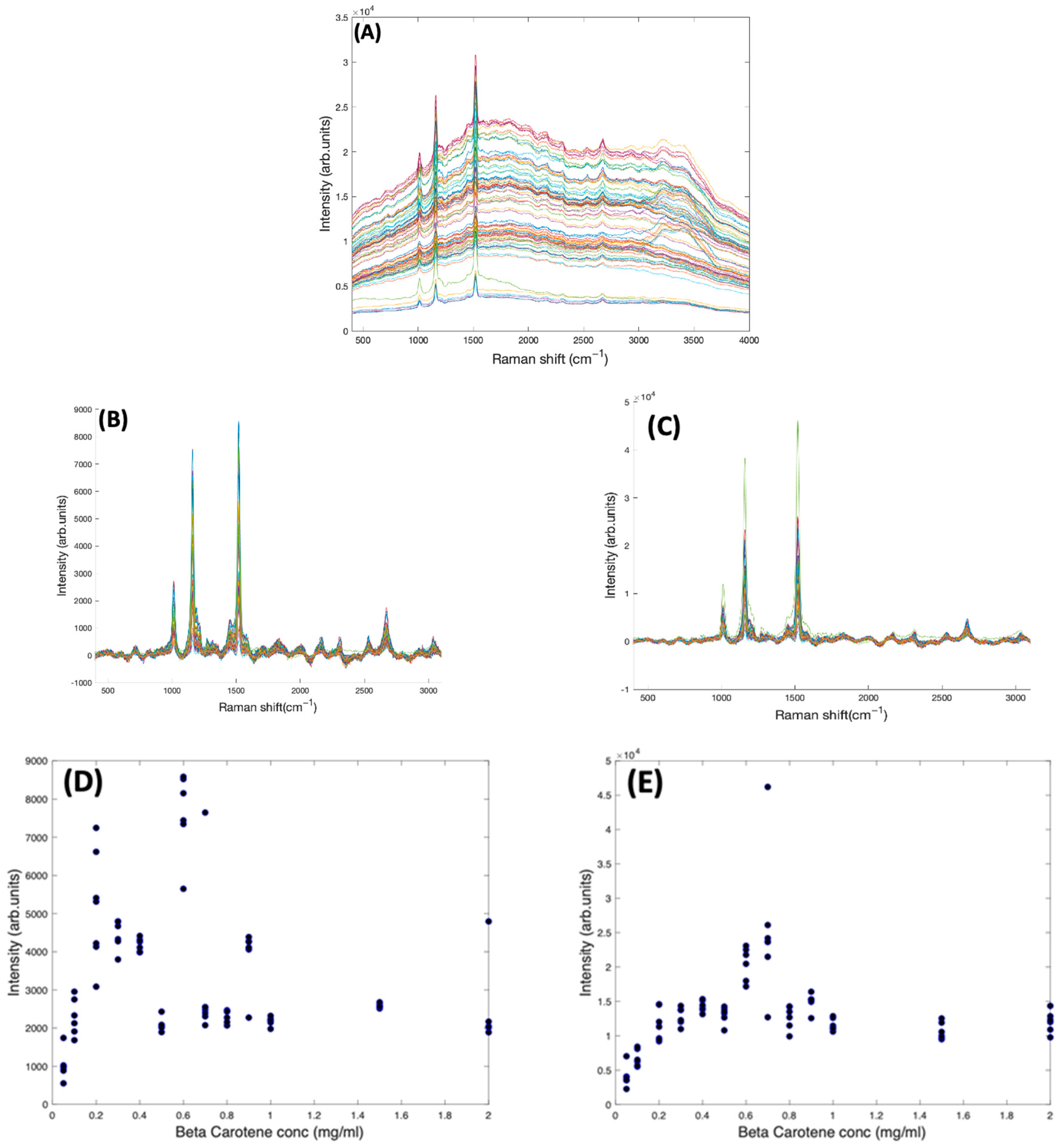
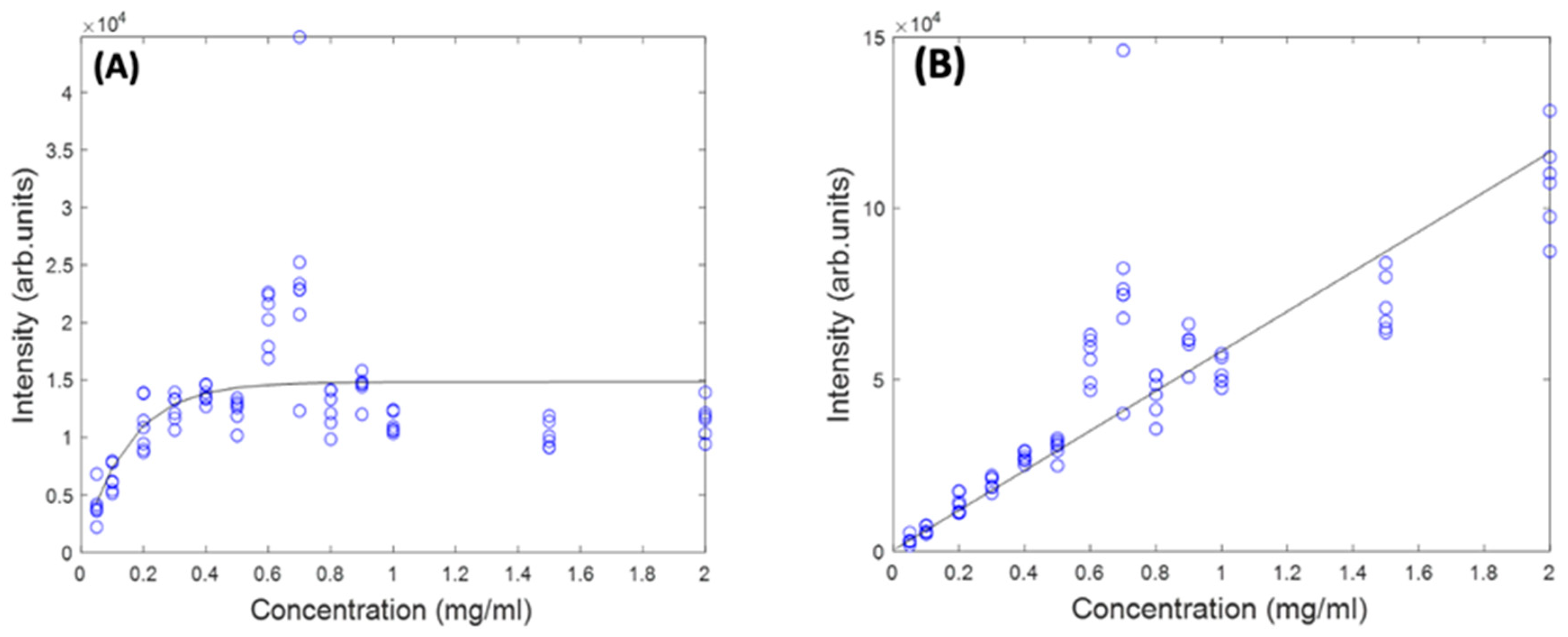

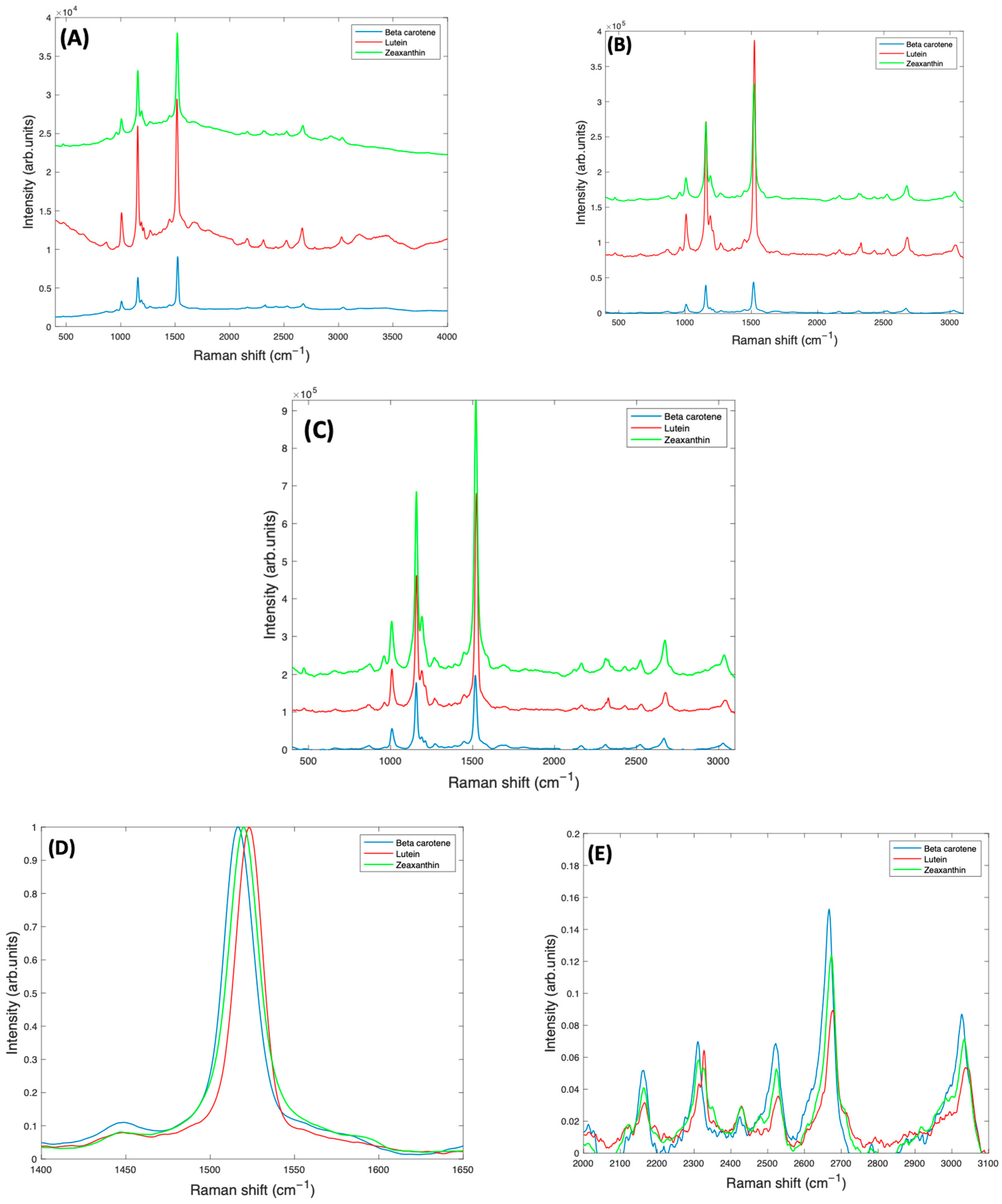

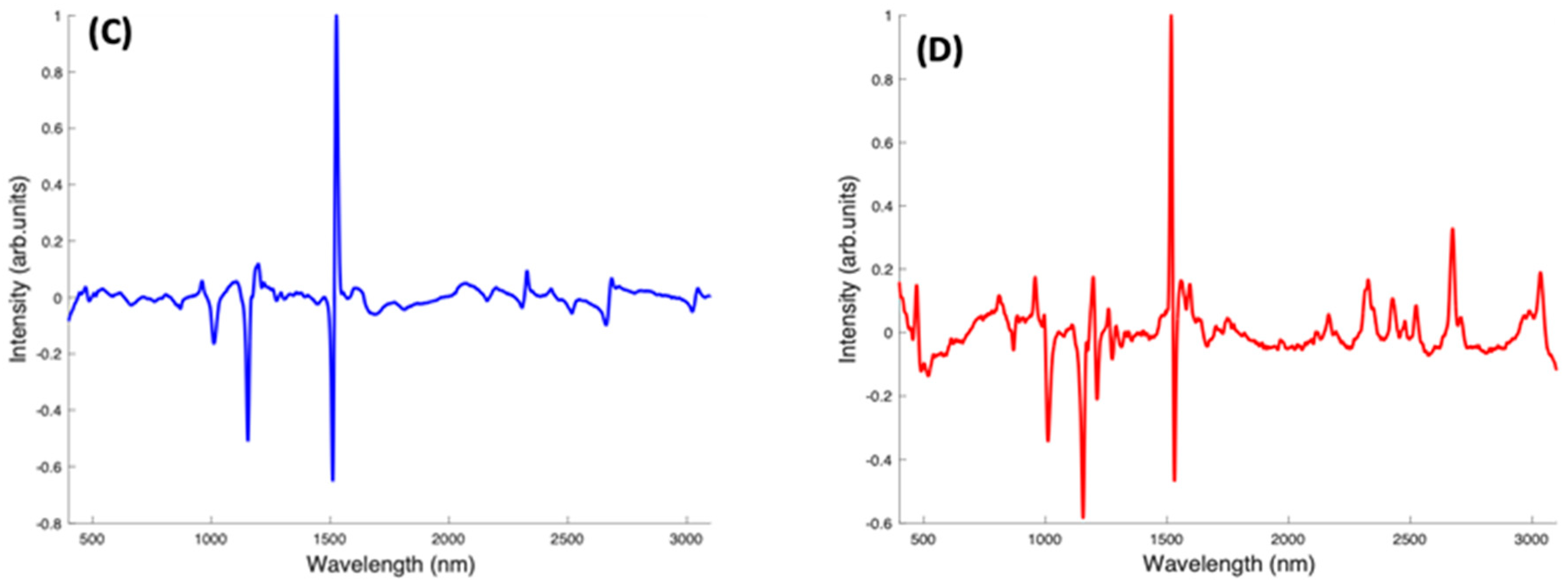
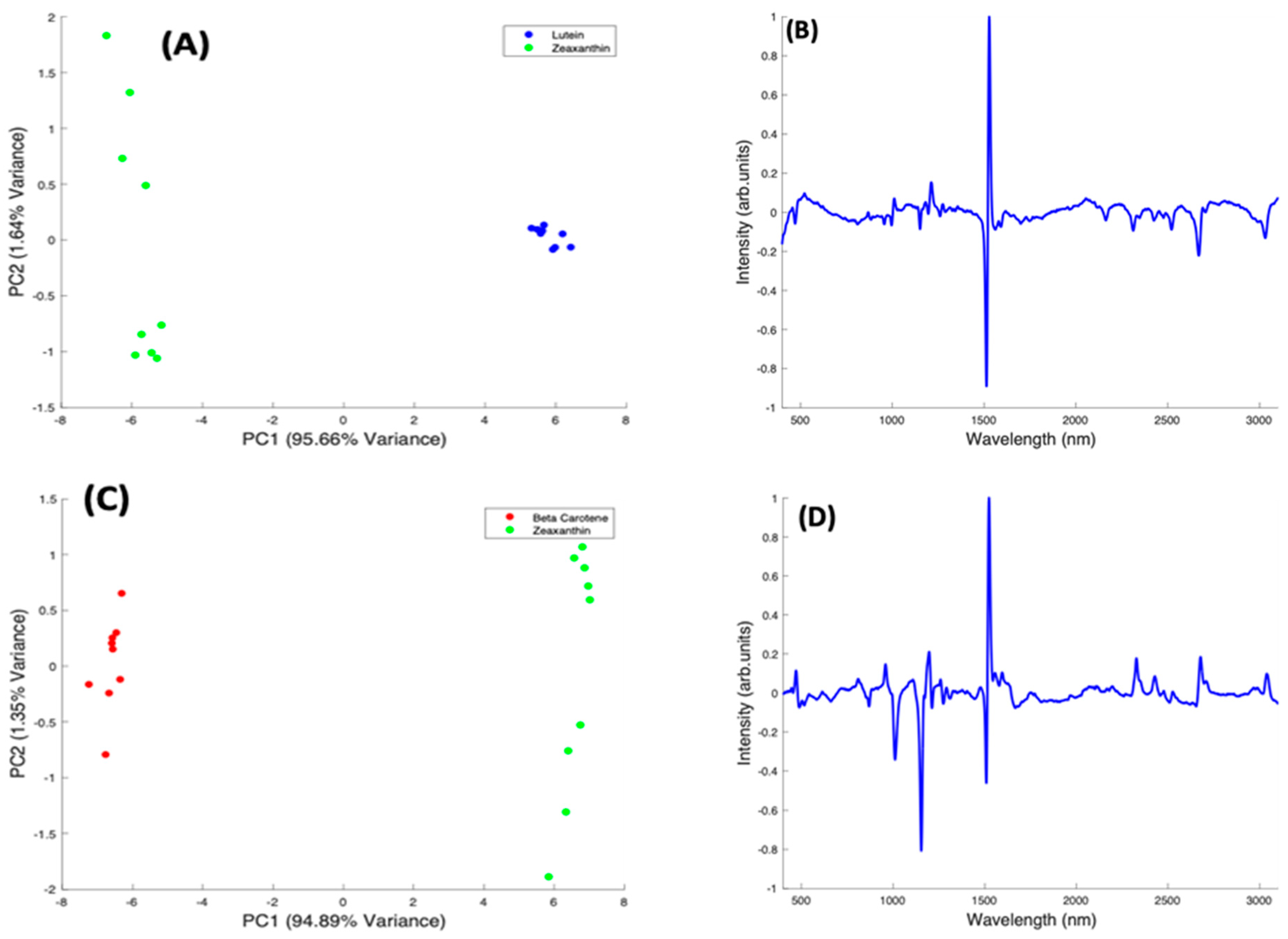

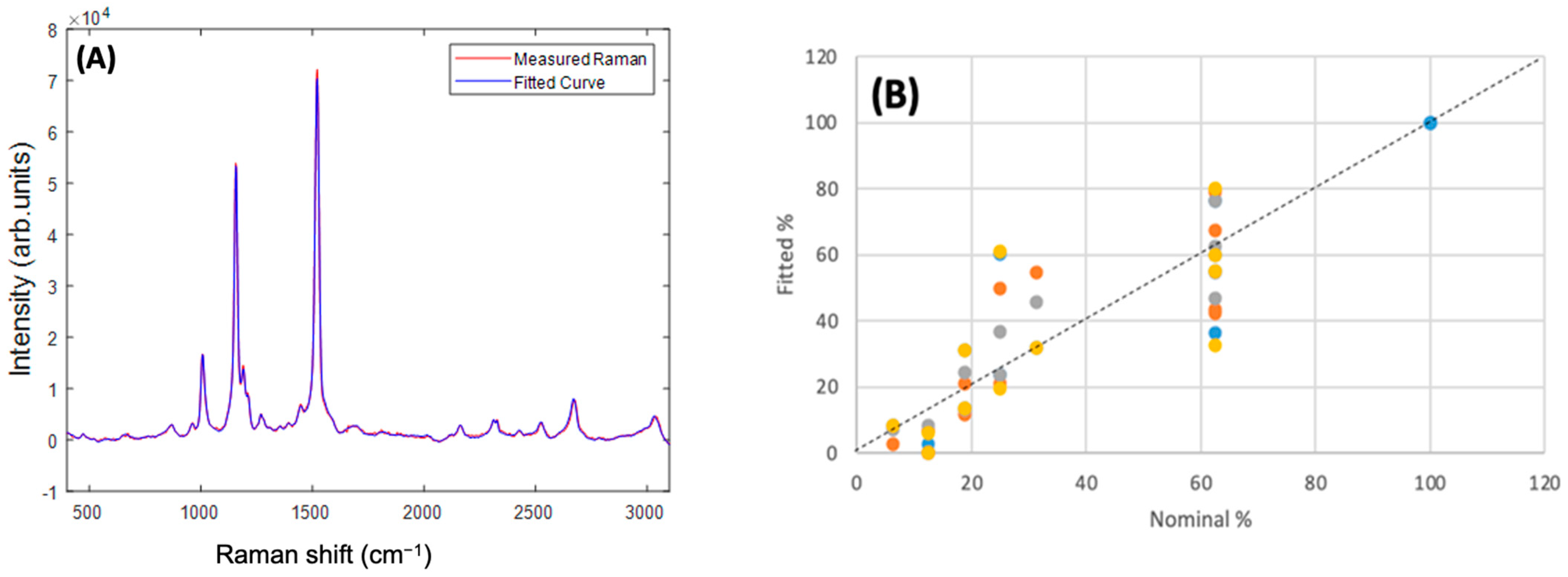
Publisher’s Note: MDPI stays neutral with regard to jurisdictional claims in published maps and institutional affiliations. |
© 2022 by the authors. Licensee MDPI, Basel, Switzerland. This article is an open access article distributed under the terms and conditions of the Creative Commons Attribution (CC BY) license (https://creativecommons.org/licenses/by/4.0/).
Share and Cite
Udensi, J.; Loskutova, E.; Loughman, J.; Byrne, H.J. Quantitative Raman Analysis of Carotenoid Protein Complexes in Aqueous Solution. Molecules 2022, 27, 4724. https://doi.org/10.3390/molecules27154724
Udensi J, Loskutova E, Loughman J, Byrne HJ. Quantitative Raman Analysis of Carotenoid Protein Complexes in Aqueous Solution. Molecules. 2022; 27(15):4724. https://doi.org/10.3390/molecules27154724
Chicago/Turabian StyleUdensi, Joy, Ekaterina Loskutova, James Loughman, and Hugh J. Byrne. 2022. "Quantitative Raman Analysis of Carotenoid Protein Complexes in Aqueous Solution" Molecules 27, no. 15: 4724. https://doi.org/10.3390/molecules27154724






